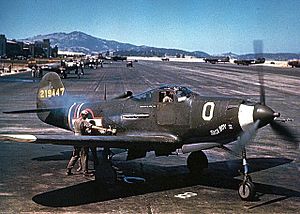Bell P-39 Airacobra facts for kids
Quick facts for kids P-39 Airacobra |
|
|---|---|
 |
|
| P-39Q 42-1947, "Saga Boy II" of Lt. Col. Edwin S. Chickering, CO 357th Fighter Group, July 1943 | |
| Role | Fighter |
| National origin | United States |
| Manufacturer | Bell Aircraft |
| First flight | 6 April 1938 |
| Introduction | 1941 |
| Status | Retired |
| Primary users | United States Army Air Forces Soviet Air Force Royal Air Force |
| Produced | 1940 – May 1944 |
| Number built | 9,588 |
| Unit cost | US$50,666 (1944) |
| Variants | Bell XFL Airabonita Bell P-63 Kingcobra |
The P-39 Airacobra was a special fighter aircraft made by a company called Bell Aircraft. It first flew in 1939 and was used in battles starting in 1941. This plane had really strong weapons, but it was also known for being a bit tricky to fly and could sometimes lose control easily.
The Airacobra was fast, but it didn't fly very well high up in the sky, especially above 5,000 meters (about 15,000 feet). This was because it didn't have a special engine part called a turbocharger that helps planes fly higher.
The Soviet Union used the P-39 a lot during World War II. They used it to stop enemy planes, especially in battles that happened closer to the ground. Near the ground, the Airacobra was super easy to turn and could even outmaneuver German planes! Russian pilots really liked this plane. They often took off the guns from the wings to make it even lighter and easier to turn. Many Soviet pilots became fighter aces (pilots who shot down many enemy planes) while flying the P-39.
The main weapon of the P-39 was a powerful 37 mm cannon. This cannon was so strong that it could often destroy an enemy airplane with just one hit!
Two famous Soviet pilots, Grigori Rechkalov and Aleksandr Pokryshkin, were incredibly successful with the Airacobra. Grigori Rechkalov shot down 57 German planes while flying the Airacobra. His friend, Aleksandr Pokryshkin, had 59 victories in total, and 47 of those were with the Airacobra.
The P-39 was quite different from most other planes in World War II. It had a "tricycle" landing gear, which means it had a wheel at the front and two wheels under the wings, like a tricycle. Most other planes at the time had two main wheels and a small wheel at the back. Also, its doors opened like a car door, which was unusual for a fighter plane. Pilots usually had to climb out of the top of other fighters. Another unique thing was that its engine was placed behind the pilot, not in front.
The "Q" version of the P-39 could fly at 375 miles per hour (600 km/h). It was armed with four 12.7mm machine guns and that powerful 37mm cannon.
Images for kids
-
601 Squadron Airacobra I. The long-barrelled 20 mm Hispano-Suiza cannon Hispano is clearly shown, as are the .303 wing guns.
-
P-39Q on display at the Air Zoo
-
P-39Q at the National Museum of the U.S. Air Force. This winter diorama shows ground crew with a Type F-1A Utility Heater in front of an Airacobra flown by Lt. L. Spoonts of the 57th FS based on Adak Island during the Aleutians Campaign in 1942.
See also
 In Spanish: Bell P-39 Airacobra para niños
In Spanish: Bell P-39 Airacobra para niños




















